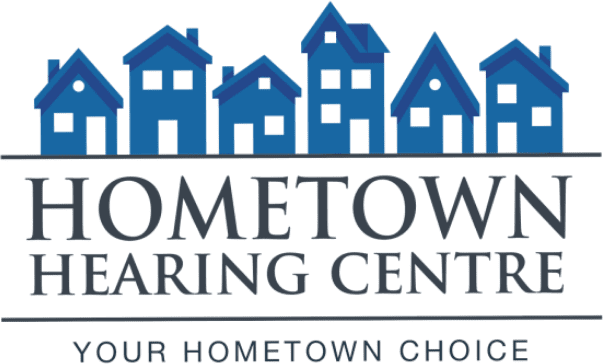Where Guelph Goes to Get Their Hearing Tested!
Whether it’s children laughing, a conversation with your best friend, your favourite TV show, birds chirping or the sound of crickets on a warm summer evening, hearing makes it possible to enjoy a rich and rewarding lifestyle.
However, many who begin experiencing a hearing loss put off seeking the help they need for up to ten years, continuing to do additional damage to their hearing as well as running the risk of developing other negative health conditions, such as anxiety, depression, cognitive decline and balance disorders.
You might be wondering, “Is there a place to get a hearing assessment near me?”
Hometown Hearing Centre in Guelph has you covered! Our experienced, licensed team uses advanced equipment to provide highly accurate hearing assessments. From there, we tailor personalized solutions to address your specific hearing needs, helping you reconnect with the sounds that matter most.

Types of Hearing Loss and Their Characteristics

Types of Hearing Loss
Sensorineural Hearing Loss
The most common type of permanent hearing loss is sensorineural hearing loss, which involves damage to either the tiny hair-like cells of the inner ear, known as stereocilia, or the auditory nerve that transfers sound signals to the brain.
Although children can be born with a sensorineural hearing loss, which is most likely related to a genetic syndrome or an infection passed from mother to fetus inside the womb, most cases of sensorineural hearing loss develop later in life in relation to normal aging (known as presbycusis or age-related hearing loss) or ongoing exposure to loud noise.
Less common causes can include:
- Heart disease and diabetes
- Infections, such as mumps
- Meniere's disease
- A side effect of ototoxic drug or medication use
- Acoustic neuroma or other cancerous growths in the inner ear
- Concussions and traumatic brain injuries that damage the inner ear or auditory nerve
- Autoimmune diseases, including thyroid disease
Hearing challenges related to both loudness and clarity are common signs of sensorineural hearing loss as well as a feeling of unsteadiness or dizziness, tinnitus and early onset dementia or cognitive decline.
Types of Hearing Loss
Conductive Hearing Loss
This type of hearing loss is the result of some sort of obstruction or damage in the ear canal or along the hearing pathway that prevents sound signals from reaching the inner ear. Depending on what causes the obstruction, conductive hearing loss can be temporary or permanent.
Obstructions in the outer ear typically include:
- Stenosis or a narrowing of the ear canal
- Impacted earwax
- Exostoses (bone-like protrusions that develop inside the ear canal)
- Otitis externa (also known as swimmer's ear)
- Obstructions caused by foreign bodies inserted into the ear
- Microtia or atresia (congenital deformities)
Obstructions in the middle ear tend to be related to:
- Breach in the tympanic membrane (eardrum)
- Tympanosclerosis (thickening of the tympanic membrane)
- Otitis media (ear infection) fluid in the middle ear
- Blockages in the Eustachian tube
- Otosclerosis (affects the tiny middle ear bone known as the stapes)
- Abnormal growths or tumours, such as cholesteatoma or glomus tumours
- Ossicular chain discontinuity, or a break in the connection between the bones of the middle ear, due to injury
The sensory organs of the inner ear remain intact with conductive hearing loss, so hearing challenges related to conductive hearing loss involve loudness rather than clarity. Consequently, individuals with this type of hearing loss tend to turn up the volume on the television or radio to improve hearing.
Types of Hearing Loss
Mixed Hearing Loss
Mixed hearing loss is any combination of sensorineural and conductive hearing loss. In most cases involving mixed hearing loss, either sensorineural or conductive hearing loss is already present and the other develops afterward, but there are three instances that can lead to this combination hearing loss, including:
- A person with a sensorineural hearing loss experiences some sort of trauma that leads to additional conductive hearing loss.
- A person with a conductive hearing loss develops a sensorineural hearing loss due to normal aging.
- Blast injuries or other types of trauma can cause both sensorineural and conductive hearing loss.
Individuals with a mixed hearing loss will experience both clarity and loudness issues related to each type of hearing loss.
Common Tests Used to Assess Hearing Loss
This test allows a hearing clinician to measure the reaction of the eardrum when a subtle pressure change is introduced into the ear canal. The information gathered helps identify the presence of fluid behind the eardrum, a ruptured eardrum or other middle ear issues.
This test helps identify the type and severity of your hearing loss, establishing your hearing threshold, or the lowest level at which two of three responses are given for the same frequency. It involves the transmission of pure tones presented in descending levels from 250 Hz-8000 Hz transmitted through the ear canal using headphones.
Speech Reception Threshold (SRT) testing involves asking you to repeat spondee words (composed of two syllables pronounced with equal stress and effort) presented in descending levels in order to establish the low-end threshold of speech reception.
Speech Discrimination Score, the second type of speech audiometry, is a percentage score of the number of phonetically-balanced words you can repeat correctly at a comfortable listening level
Similar to pure tone testing, bone conduction testing bypasses the outer and middle ear, transmitting sound signals directly to the inner ear through the surrounding bones. A comparison between pure tone test results and bone conduction test results helps determine whether your hearing loss is sensorineural or conductive.
Otoacoustic emissions (OAEs) measure how the tiny nerve cells in the cochlea (hair cells) react to the presence of sounds. The test involves inserting a soft tip into the patient’s ear. Clicking or buzzing sounds will be transmitted into the ear to stimulate certain hair cells in the cochlea.
Healthy hair cells emit a tiny response (an echo) that can be measured with special equipment in order to evaluate the extent of damage to the cochlea.
This test is used with children or others who cannot complete a typical hearing screening as well as to identify hearing loss in the brain or in a brain pathway. Testing involves the attachment of electrodes from a computer to your skin.
Data is recorded as your brain responds to sounds transmitted through the headphones. ABR is often used for early hearing loss screening in infants.
Hometown Hearing Centre’s Five Step Testing Process
1. A warm welcome to our clinic.
Our staff greets you the minute you walk in and makes sure that you’re comfortable. We’ll make sure that the necessary information on the required forms is in order and make you feel at home while you wait for your consultation.
2. A conversation about you.
3. A physical examination of your ears.
4. A series of tests to measure your hearing.
5. A discussion about the results of your tests.
Schedule a Hearing Assessment with Our Professionals
Being able to hear children laughing, a conversation with your best friend, your favourite TV show, birds chirping, the sound of crickets on a warm summer evening or other sounds you love help make life worth living.
With a comprehensive hearing assessment conducted by one of our professionals, you can help ensure that you can hear as long as possible.
Contact the Southern Ontario Hometown Hearing Centre location nearest you in order to schedule a hearing assessment by using the adjacent form, and a member of our team will call you in order to provide assistance.
Don’t want to wait? Call us today.
